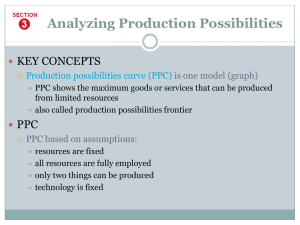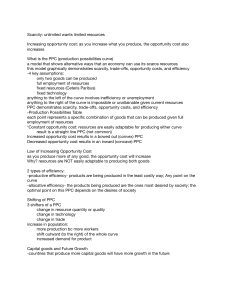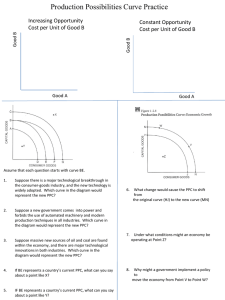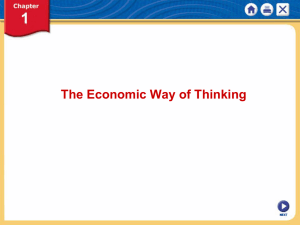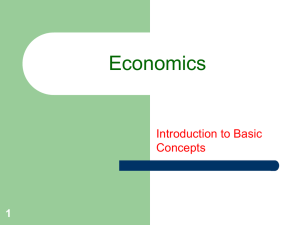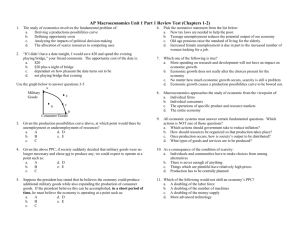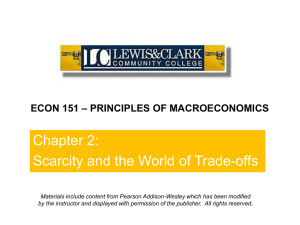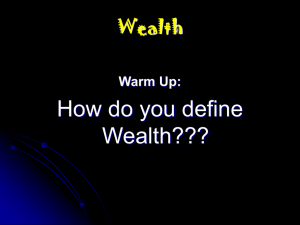Chapter 1 Notes - DHS Economics Webpage
advertisement
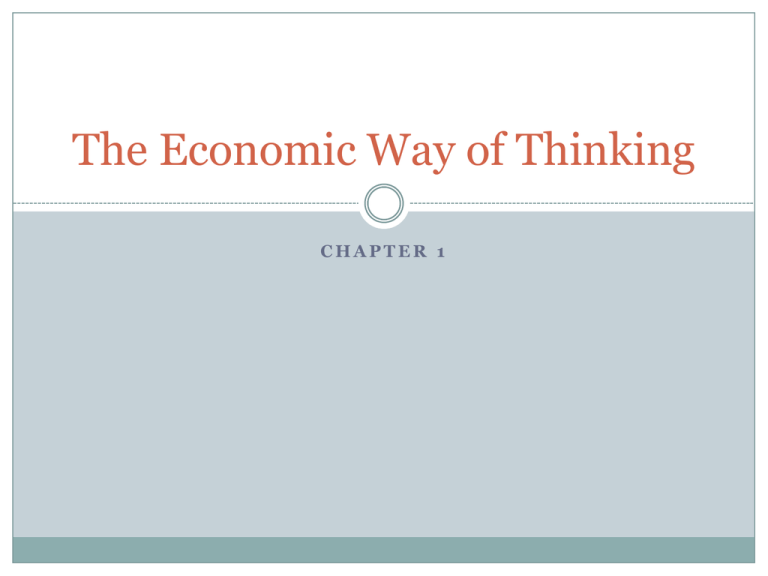
The Economic Way of Thinking CHAPTER 1 Scarcity: The Basic Economic Problem KEY CONCEPTS Economics — study of how people use resources to satisfy wants how individuals/societies choose to use resources organizes, analyzes, interprets data about economic behaviors develops theories, economic laws to explain economy, predict future Scarcity: The Basic Economic Problem Scarcity is the economic problem of having seemingly unlimited human needs and wants, in a world of limited resources. Why does it exist? It exists because wants are unlimited and resources are limited Basic Economic Principles Principle 1: People Have Wants Wants — desires that can be met by consuming products Needs — things necessary for survival Scarcity — lack of resources available to meet all human wants, not a temporary shortage People make choices about all their needs and wants Wants are unlimited, ever changing Basic Economic Principles Principle 2: Scarcity Affects Everyone Scarcity affects which goods and services are provided Goods — physical objects that can be bought Services — work one person does for another for pay Consumer — person who buys good or service for personal use Producer — person who makes a good or provides a service Video Clip: Scarcity & Choice Three Basic Economic Questions Every society must answer three basic economic questions because of scarcity. Societies answer these questions differently, leading to a variety of economic systems. Three Basic Economics Questions Question 1: What Will Be Produced? Societies must decide on mix of goods to produce depends on their natural resources Some countries allow producers and consumers to decide In other countries, governments decide Must also decide how much to produce; choice depends on societies’ wants Three Basic Economics Questions Question 2: How Will It Be Produced? Production decisions involve using resources efficiently Influenced natural resources Societies adopt different approaches labor-intensive methods versus capital-intensive methods depends on availability Three Basic Economics Questions Question 3: For Whom Will It Be Produced? How goods and services are distributed involves two questions how should each person’s share be determined? how will goods and services be delivered to people? The Factors of Production Factors of production resources needed to produce goods and services 1. land 2. labor 3. Capital 4. entrepreneurship supply is limited The Factors of Production Factor 1: Land Land means all natural resources on or under the ground includes water, forests, wildlife, mineral deposits The Factors of Production Factor 2: Labor Labor is all the human time, effort, talent used to make products physical and mental effort used to make a good or provide a service The Factors of Production Factor 3: Capital Capital is a producer’s physical resources includes tools, machines, offices, stores, roads, vehicles sometimes called physical capital or real capital Workers invest in human capital — knowledge and skills workers with more human capital are more productive The Factors of Production Factor 4: Entrepreneurship Entrepreneurship — vision, skill, ingenuity, willingness to take risks Entrepreneurs anticipate consumer wants, satisfy these in new ways develop new products, methods of production, marketing or distributing risk time, energy, creativity, money to make a profit Practice Label the 4 Factors f Production (CL Lesson 5, pg 26) Factors of Production CL Lesson 6 Activity in groups of 2 -3 . Making Economic Choices Two factors affect economic decisions: 1. 2. Incentives — benefits that encourage people to act in certain ways Utility — benefit or satisfaction gained from using a good or service Choices vary between individuals based on what is best for him / her Making Economic Choices Factor 1: Motivations for Choice People motivated by incentives, expected utility, desire to economize They weigh costs against benefits to make purposeful choices Motivated by self-interest Making Economic Choices Factor 2: No Free Lunch All choices have a cost choosing one thing means giving up another, or paying a cost cost can take form of money, time, other thing of value Trade-Offs and Opportunity Cost Trade-off is alternative people give up when they make a choice usually means giving up some, not all, of a thing to get more of another Trade-Offs and Opportunity Cost Example of a Trade Off Jessica wants to earn college credit over summer semester-long university course offers more credits six-week high school course leaves time for vacation Trade-Offs and Opportunity Cost Opportunity cost is value of next-best alternative a person gives up not the value of all possible alternatives Example of Opportunity Cost Dan chooses to work for six months so he can travel for six months opportunity cost = six months of salary Video Clip: Opportunity Cost Opportunity Cost Activity In a group of 2 -3 consider this scenario: You have won $1,000. Create a chart with these columns: What will you buy? What will you gain from each choice? What do you give up with each choice? (What’s the opportunity cost?) Analyzing Economic Choices Cost-benefit analysis: examines the costs and expected benefits of choices one of most useful tools for evaluating relative worth of economic choices Analyzing Economic Choices Marginal Costs and Benefits Marginal cost additional cost of using one more unit of a good or service Marginal benefit additional benefit of using one more unit of a good or service Analyzing Production Possibilities KEY CONCEPTS Production possibilities curve (PPC) is one model (graph) PPC shows the maximum goods or services that can be produced from limited resources also called production possibilities frontier PPC PPC based on assumptions: resources are fixed all resources are fully employed only two things can be produced technology is fixed Graphing the Possibilities Production Possibilities Curve PPC runs between extremes of producing only one item or the other Data is plotted on a graph; lines joining points is PPC shows maximum number of one item relative to other item PPC shows opportunity cost of each choice more of one product means less of the other What We Learn from PPCs Efficiency — producing the maximum amount of goods and services possible Underutilization — producing fewer goods and services than possible Why is the PPC a Curve? Law of increasing opportunity costs as production switches from one product to another, more resources needed to increase production of second product Reasons for increasing cost of making more of one product need new resources, machines, factories must retrain workers Costs paid by making less and less of other product Let’s Look at Some Examples PPC Practice Changing Production Possibilities A country’s supply of resources changes over time Example: U.S. in 1800s grew, gained resources, workers, new technology new resources mean new production possibilities beyond frontier Increased production shown on PPC as shift of curve outward Increase in total output called economic growth PPF—The Curve What Does Guns And Butter Curve Mean? In a theoretical economy with only two goods, a choice must be made between how much of each good to produce. As an economy produces more guns (military spending) it must reduce its production of butter (food), and vice versa. Video Clip: Individual and Society PPCs CL Lesson 7 Activity pg. 35 – PPC Problems Microeconomics and Macroeconomics Microeconomics Microeconomics examines specific, individual elements in an economy prices, costs, profits, competition, consumer and producer behavior Some Topics of Interest: business organization, labor markets, environmental issues Microeconomics and Macroeconomics Macroeconomics Macroeconomics studies sectors — combination of all individual units Includes consumer, business, public or government sectors Macroeconomics studies national or global topics: monetary system, business cycle, tax policies, international trade Examples of Macro and Micro Which is it? 1. 2. 3. 4. 5. National Unemployment Figures Rise World Trade Organization Meets Shipbuilder Wins Navy Contract Cab Drivers on Strike! Gasoline Prices Jump 25 Cents
